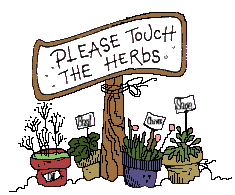| Back to Index |
 How to Harvest, Dry, and Store Herbs
How to Harvest, Dry, and Store HerbsHarvesting
| Back to Index |
 How to Harvest, Dry, and Store Herbs
How to Harvest, Dry, and Store Herbs| AA = as available BF = before flowering WB = while in bud stage WF = while flowering D = dried (precedes F, L, R, or S) |
F = flower L = leaf R = root S = seed X = whole form | |||||||
| HERB | PART USED | HARVEST | STORE | HERB | PART USED | HARVEST | STORE | |
|---|---|---|---|---|---|---|---|---|
| Angelica | S | AA | DS | Lemon Balm | L | BF | DL | |
| R | Fall of 1st year | DR | Lovage | L, stems | WF | DL, D-stems | ||
| L, stems | BF | DL, D-stems | S | AA | DS | |||
| Anise | S | AA | DS | R | fall | DR | ||
| Anise Hyssop | L | BF | DL | |||||
| F | WF | DF | Marigold, Lemon Gem | petals | AA | Use fresh | ||
| Marigold, Tarragon | L | AA | DL | |||||
| Basils | L | AA | DL | Marjoram | L | BF, WF | DL | |
| Beebalm | L, F | WF | DL | Marjoram, Sweet | L | BF, WF | DL | |
| Blackberry | L | BF | DL | Mints | L | BF, WB | DL | |
| Boneset | F, L | WF | DF, DL | Motherwort | L, flowering tops | WF | DL & tops | |
| Borage | F, L | WF | DF, DL | Mugwort | L, stems | WB | DL, D-stems | |
| Mullein | F | AA | DF | |||||
| Calendula | F | WF | D petals | L | AA | DL | ||
| Catnip | L | BF, WF | DL | |||||
| Chamomile | F | WF | DFX | Nettle, Stinging | L | BF | DL | |
| Chickory | R | Fall | DR | |||||
| Chickweed | Plant | WF | D plant | Oregano | L | BF, WF | DL | |
| Cilantro | L | AA | Use fresh | |||||
| Clover, Red | F | WF | DFX | Parsley | L | AA | DL | |
| *Comfrey | young growing tips | BF | DL | Pennyroyal, Eng. | L | WB | DL | |
| R | Fall | DR | Pumpkin | S | AA | DS | ||
| Coriander | S | AA | DS | *Pyrethrum, Dalmation | F | WF | DF | |
| Costmary | L | BF | DL | |||||
| Dandelion | L | AA | DL | Raspberry, Red | L | WF | DL | |
| F | spring | Use fresh | Rosemary | F, L | AA | DF, DL | ||
| R | fall | DR | ||||||
| Dill | L, S | AA | DL, DS | Sage | L | BF, WF | DL | |
| Sage, Pineapple | F, L | BF, WF | DF, DL | |||||
| Echinacea | R | Fall of 2nd year | DR | Savory | L | BF | DL | |
| Elderberry | F | WF | DF | Selfheal | Plant | WF | D-plant | |
| Elecampane | R | Fall of 2nd year | DR | Skullcap | Plant | WF | D-plant | |
| Ephedra | plant | WF | D plant | Southernwood | L | BF, WF | DL | |
| Evening Primrose | F, L | WF | DF, DL | Speedwell | Plant | WF | D-plant | |
| Sweet Cicely | L | BF | DL | |||||
| Fennel | S | AA | DS | S | AA | DS | ||
| Feverfew | F, L | WF | DF, DL | R | Fall | DR | ||
| Sweet Woodruff | L, soft stems | BF, WF | DL, D-stems | |||||
| Hops | Female strobiles | When amber brown | D strobiles | |||||
| Horehound | L | WB | DL | *Tansy | F, L | WF | DF, DL | |
| Horseradish | R | Fall aft. 1 or 2 frosts | DR, or use fresh | Tarragon | L | Early & late summer | DL | |
| Hyssop | L | WF | DL | Thymes | L | WF | DL | |
| . | ||||||||
| Lady's Bedstraw | R | Fall | DR | Valerian | R | Fall | FR, DR | |
| Lady's Mantle | F, L | WF | DF, DL | Violet, Sweet | F, L | BF, WF | DF, DL | |
| Lavender | F in full bud stage | WB | D bud | |||||
| Yarrow | F, L | WF | DF, DL | |||||
| *Indicates a plant not meant for internal use. The term plant refers to the above ground portion of the plant. | ||||||||